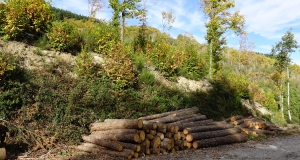The Marganai area, along with the entire Sulcis-Iglesiente region, has been an important site of mining exploitation for several centuries. This activity is reflected by the numerous underground tunnels built from the Phoenician-Punic period and during the subsequent historical periods when Roman, Spanish, Pisan and Piedmontese exploited the area’s mineral richness (Valery, 1996, Wagner, 2001).
A recent historical research on the municipality of Domusnovas (Costa and Canavera, 2001) revealed that woodland utilizations in the Oridda area, which is part of the current Marganai forest, were already practiced during the 18th century), when the Savoy government planned to repopulate the territory of the County of Oridda. In particular, it seems that from 1766 Francesco Fulgheri, Count of San Giovanni Nepumuceno, exploited the forest resources of the area. This activity continued until 1838, when the fiefdom was redeemed and granted to the municipality of Domusnovas.
Several authors described the strong relationship between mining activity and forest management in the period between the 18th and 19th centuries. Moreover, several documents tell about the management of these woodlands through the practice of coppicing, aimed at the production of charcoal and railway sleepers (Beccu, 2000; Ballero et al 1995; Falchi, 1952).
Enea Beccu (2000) describes in detail the 1844 master plan according to which the County of Oridda, which was characterized by the practices of coppicing and acorn grazing, was regulated. From the first half of the 18th century to the second half of the 19th the County was managed by several companies, ranging from the Conte Beltrami to the Semenza Company, and the Company of Monteponi which owned the County until 1979 (Costa and Canavera, 2001; Ballero et al., 1995). Throughout this period the forest management was strictly connected to mining activities, even with quite intense utilizations. Costa and Canavera (2001) quote a 1909 note of the forest workers of Oridda which shows how important the production of charcoal was, justifying the presence of dozens of workers from other regions of Italy, mainly from Tuscany and Emilia Romagna (Falchi, 1952).
During the 19th century the extent of charcoal production had become considerably large. In 1864 there was a high consumption by the foundries of Sulcis-Iglesiente, and a few years later the charcoal was exported to France, Spain and other parts of the Kingdom of Italy. Firewood and charcoal were the main source of heating in private houses (kitchens, stoves, fireplaces), as well as the dairy industry.
The charcoal and firewood market developed for almost the entire 20th century. In 1979 the Marganai forest was acquired as part of the non available estate of the Region of Sardinia, becoming a state-owned forest. Ballero et al. (1995) describe these woods as “overaged oak coppice with standards intended for the production of charcoal and mine poles with a length of the coppice cycle ranging from 18 to 25 years” and highlight the fact that "since the early years of the century, the woodlands owned by the Monteponi Company were managed according to a specific forest management plan with not particularly intense uses which have left a precious legacy of overmature coppice structures”.
Since the seventies of the last century there has been a gradual abandonment of silvicultural management. In 2010, after the approval of a management plan for the Marganai forest, a planning process aimed at recovering the public compendium’s historical silvicultural management on small areas was launched (see graph). The management plan envisages restoring the practice of coppicing over an area of 401 ha, following a space-time design based on 3 year chronological classes. The planned interventions involve limited areas to be managed over a ten year period. The areas to be coppiced were identified through a quali-quantitative analysis of the forest stands and the geomorphological features of the management units.
References
Ballero M., Boni C., Canu G., Cocco S. e Delogu G. 1995 “Guida al giardino Linasia e alle foreste Demaniali di Marganai, Montimannu e Gutturu Pala” Azienda Foreste Demaniali della Sardegna. Stef srl, Cagliari
Beccu E., 2000. Tra cronaca e storia le vicende del patrimonio boschivo della Sardegna. Carlo Delfino editore, Sassari.
On line http://www.sardegnaambiente.it/j/v/152?s=24911&v=2&c=1557&t=1
On line: http://www.sardegnaambiente.it/j/v/152?s=281225&v=2&c=12078&t=1
Costa R.L. e Canavera E., 2001. Domusnovas dalle origini al ‘900. Comune di Domusnovas.
Falchi M., 1952. Aspetti principali del problema forestale in Sardegna. Regione autonoma della Sardegna, Assessorato all’agricoltura e foreste, Cagliari, 1952.
Valery. Viaggio in Sardegna. Valery; traduzione e cura di Maria Grazia Longhi. Nuoro Ilisso c1996 - 320p.
Wagner MAx Leopold. Immagini del viaggio di Sardegna / Max Leopold Wagner; a cura di Giulio Paulis; traduzione di Giovanni Masala. Nuoro: Ilisso c2001 - 173 p.












